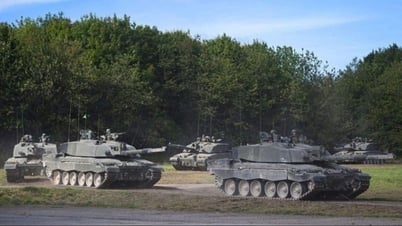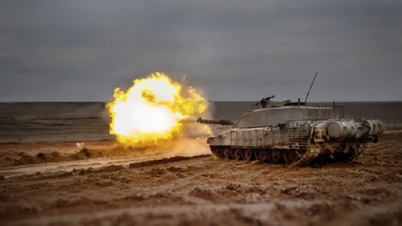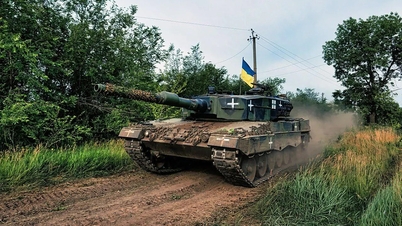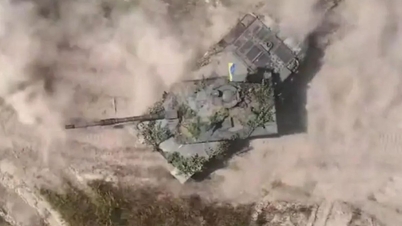Ukrainian soldiers installed a steel plate on the front of the Challenger 2 tank's undercarriage to protect this weak point from Russian anti-tank missiles.
A video that surfaced on social media last week shows the Challenger 2 main battle tank number 506 of the 82nd Airborne Brigade moving in the southern part of the country. A prominent feature of the Challenger 2 in the video is a steel plate attached to the front sloping undercarriage of the vehicle.
Forbes editor David Axe said the Challenger 2 was one of the best-armored tanks in the world , with Dorchester protection on the turret equivalent to 1,400 mm of rolled steel. However, due to decades of British tank deployment in fortifications, the front sloping undercarriage had only light armor.
The British Army later added additional armor to protect this position, but it appears that the Challenger 2s they supplied to Ukraine lacked such accessories, leaving them vulnerable to shots to the front underbody. “British officials almost expect Ukraine to use these Challenger 2s defensively,” Axe writes.
But on the battlefield, the Ukrainian 82nd Airborne Brigade, the sole operator of the 14 Challenger 2s provided by the UK, was advancing on the Rabotino axis in a large-scale counter-offensive. As a result, Ukrainian soldiers had to install homemade underbody protection on their Challenger 2 tanks.
Ukrainian Challenger 2 tank with homemade steel armor in video released on September 23. Video: X/Military Land
Homemade armor can overcome the Challenger 2's inherent weakness in the front, but Russian soldiers seem to have discovered another weak point in the turret roof of this vehicle against the 9M133 Kornet anti-tank missile.
This is what the Ukrainian Challenger 2 suffered during the battle near the village of Rabotino, which the country's forces recaptured in mid-August.
The Challenger 2 apparently hit a mine while moving from Rabotino to the nearby village of Verbovoe. Russian soldiers fired a Kornet anti-tank missile that hit the Challenger 2's turret roof, causing the tank to burn out.
"The missile gunner appears to have used an air-to-air attack mode. The Kornet multi-explosive round detonated above the Challenger 2 turret roof, a thinly armored location with no additional protection," Axe wrote.
The strike appears to have ignited the Challenger 2’s shells, which were stored in special storage compartments designed to prevent secondary explosions. However, the compartments appear to have been ineffective, as the shell explosions caused the Challenger 2’s turret to detach from the hull, though not blow it off like the Russian T-72.
"This was a bad situation for the Challenger 2, which suffered two consecutive hits. The first was an anti-tank mine that damaged the tracks, immobilizing the Challenger 2, and then a hit to the turret roof," Axe wrote. "This seems to be a tactic the Russians have discovered to destroy the Challenger 2 tank."
A destroyed Challenger 2 tank near the village of Rabotino, Zaporizhzhia province, in a video released on September 5. Video: Twitter/OSINTtechnical
The Challenger 2 main battle tank was developed by the UK in the late 1980s, equipped with a 120mm main gun. This is the only NATO tank line to use a rifled gun barrel, as the British army preferred to use high explosive flexible-head (HESH) ammunition instead of the APFSDS ammunition common with smoothbore guns.
HESH rounds have a superior range compared to APFSDS, making them highly effective against fortified structures or thinly armored vehicles such as enemy infantry fighting vehicles. However, their penetration ability is inferior to kinetic energy rounds and they are almost ineffective against the complex armor on modern main battle tanks.
This tank model weighs 62.5 tons, equipped with a V-12 diesel engine with a capacity of more than 1,200 horsepower, helping it reach a maximum speed of 59 km/h on flat roads and 40 km/h when crossing terrain.
Nguyen Tien (According to Forbes )
Source link





![[Photo] National Assembly Chairman Tran Thanh Man receives United Nations Secretary-General Antonio Guterres](https://vphoto.vietnam.vn/thumb/1200x675/vietnam/resource/IMAGE/2025/10/25/1761390815792_ctqh-jpg.webp)
![[Photo] Prime Minister Pham Minh Chinh and United Nations Secretary-General Antonio Guterres attend the Press Conference of the Hanoi Convention Signing Ceremony](https://vphoto.vietnam.vn/thumb/1200x675/vietnam/resource/IMAGE/2025/10/25/1761391413866_conguoctt-jpg.webp)

![[Photo] Prime Minister Pham Minh Chinh receives United Nations Secretary-General Antonio Guterres](https://vphoto.vietnam.vn/thumb/1200x675/vietnam/resource/IMAGE/2025/10/25/1761390212729_dsc-1484-jpg.webp)

























![[Photo] President Luong Cuong receives heads of delegations attending the signing ceremony of the Hanoi Convention](https://vphoto.vietnam.vn/thumb/1200x675/vietnam/resource/IMAGE/2025/10/25/1761377309951_ndo_br_1-7006-jpg.webp)
![[Photo] General Secretary To Lam meets with General Secretary and President of Laos Thongloun Sisoulith](https://vphoto.vietnam.vn/thumb/1200x675/vietnam/resource/IMAGE/2025/10/25/1761380913135_a1-bnd-4751-1374-7632-jpg.webp)













































































Comment (0)